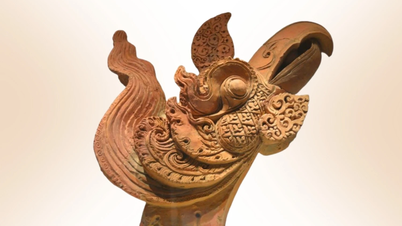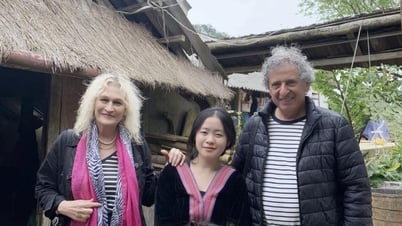The portrait of Shangguan Wan'er in Chinese films or history is rarely recognized by scholars for her talent or resourcefulness, but only emphasizes the detail that she was a flattering beauty, loyal to Wu Zetian, and participated in factional conflicts in the palace.
However, when a large mausoleum was discovered near Xianyang Airport in Xi'an, Shaanxi Province, in June 2013, the history of Shangguan Wan'er, a famous woman of the Tang Dynasty in China, was gradually revealed.

Actress Nhu Binh plays Thuong Quan Uyen Nhi in the 1995 film Vo Tac Thien. (Photo: Baidu)
Shangguan Wan'er was born in 664 in Shanzhou, Henan Province, central China today. According to legend, her mother, Zheng Shi, before giving birth, dreamed of a giant giving her a scale and saying: "Take this and weigh the people in the world" . Because of this saying, Zheng Shi believed that the child would be a boy, with extraordinary talent. She was unhappy when the child was born a girl, and predicted that she would become the "scale" to measure the people in the world.
Shangguan Wan'er's father and grandfather were both officials in the Tang Dynasty, but were forced to death by Empress Dowager Wu Zetian. Ironically, 10 years later, Shangguan Wan'er was brought into the court by Empress Dowager Wu Zetian, so that she could sit next to her in important meetings and take notes. As Empress Wu Zetian's power grew, she appointed Shangguan Wan'er to be in charge of the female official team, to draft imperial edicts, and to allow her to participate in military and court affairs.
Wu Zetian held supreme power for nearly 50 years, from 656 to 705. This was an unprecedented era in Chinese history, when women held important positions in the imperial court and Shangguan Wan'er became prime minister.
Wu Zetian's daughter, Princess Taiping , also had great influence in the court. Noble women of that time often went for walks, sang, danced outside, and participated in activities such as hunting and running. They often tied their hair up high, wore tasseled hairpins, and wore clothes that left half their chest exposed. They also drank wine, wrote poems in wine houses, and accompanied their fathers or brothers to the border. They could do all the activities that noble women of the Song, Ming, and Qing dynasties could not do.
The most notable item in Shangguan Wan'er's tomb is a 1,000-year-old stone stele, intricately carved with peonies, silver and gold, and animals considered auspicious in Chinese culture. In the middle is a 982-character stele commemorating Shangguan Wan'er, a high-ranking official in the court of Wu Zetian in the 7th century. The content of the stele shows the truth is completely different from what people have long misunderstood about Shangguan Wan'er.

Tombstone of Shangguan Wan'er. (Photo: China News)
From the time Wu Zetian died in 705 until her grandson Li Longji ascended the throne as Emperor Xuanzong of Tang in 712, there was a period of turmoil. Wu Zetian's third son, Emperor Zhongzong of Tang, died in 710 after five years on the throne. Many rumors said that he was poisoned by his wife, Empress Wei.
Chinese history books have long believed that Shangguan Wan'er sided with Empress Wei and her daughter, Princess An Le. However, the contents of the tombstone show that Shangguan Wan'er resigned from office, shaved her head, and drank poison to advise Emperor Zhongzong of Tang not to let Empress Wei and her daughter take power. A few weeks after Emperor Zhongzong of Tang died, Li Longji led troops to carry out a coup and killed Shangguan Wan'er.
The content on the tombstone also makes clearer the relationship between Shangguan Wan'er and Princess Taiping. Some famous writers often dissect the relationship between the two women who had equal power during Wu Zetian's reign, making people feel like they hated each other. In fact, Princess Taiping was the one in charge of burying Shangguan Wan'er and had the stele engraved praising her talent, intelligence, and virtue.
The discovery of Shangguan Wan'er's tomb helps historians understand that the legacy she left during Wu Zetian's reign has been tarnished.
Tue Lam (Source: Sixth Tone)
Useful
Emotion
Creative
Unique
Wrath
Source




































































































Comment (0)